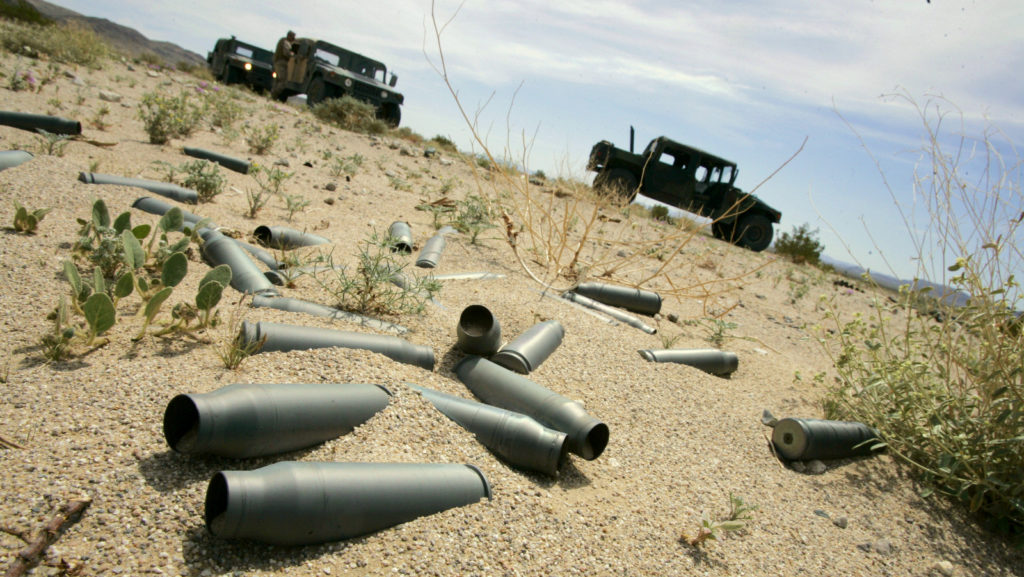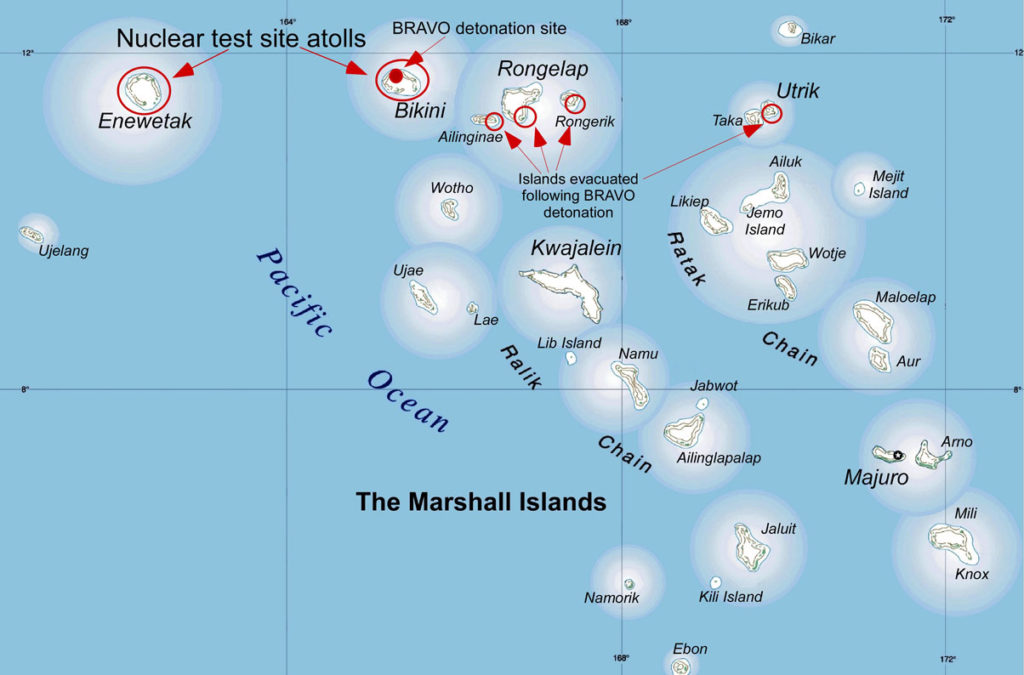U.S. Military World’s Largest Polluter – Hundreds of Bases Gravely Contaminated
ENVIRONMENT, 22 May 2017
Producing more hazardous waste than the five largest U.S. chemical companies combined, the U.S. Department of Defense has left its toxic legacy throughout the world in the form of depleted uranium, oil, jet fuel, pesticides, defoliants like Agent Orange and lead, among other pollutants.

SSpent shell casings from firing practice litter the desert of the U.S. Marine Corps’ Air Ground Combat Center at Twentynine Palms, California. (AP/Reed Saxon)
15 May 2017– Last week, mainstream media outlets gave minimal attention to the news that the U.S. Naval station in Virginia Beach had spilled an estimated 94,000 gallons of jet fuel into a nearby waterway, less than a mile from the Atlantic Ocean. While the incident was by no means as catastrophic as some other pipeline spills, it underscores an important yet little-known fact – that the U.S. Department of Defense is both the nation’s and the world’s, largest polluter.
Producing more hazardous waste than the five largest U.S. chemical companies combined, the U.S. Department of Defense has left its toxic legacy throughout the world in the form of depleted uranium, oil, jet fuel, pesticides, defoliants like Agent Orange and lead, among others.
In 2014, the former head of the Pentagon’s environmental program told Newsweek that her office has to contend with 39,000 contaminated areas spread across 19 million acres just in the U.S. alone.
U.S. military bases, both domestic and foreign, consistently rank among some of the most polluted places in the world, as perchlorate and other components of jet and rocket fuel contaminate sources of drinking water, aquifers, and soil. Hundreds of military bases can be found on the Environmental Protection Agency’s list of Superfund sites, which qualify for clean-up grants from the government.
Almost 900 of the nearly 1,200 Superfund sites in the U.S. are abandoned military facilities or sites that otherwise support military needs, not counting the military bases themselves.
“Almost every military site in this country is seriously contaminated,” John D. Dingell, a retired Michigan congressman and war veteran, told Newsweek in 2014. Camp Lejeune in Jacksonville, North Carolina is one such base. Lejeune’s contamination became widespread and even deadly after its groundwater was polluted with a sizable amount of carcinogens from 1953 to 1987.

Between 1946 and 1958, the US tested 66 nuclear weapons near Bikini atoll. Populations living nearby in the Marshall Islands were exposed to measurable levels of radioactive fallout from these tests. (Map: National Cancer Institute)
However, it was not until this February that the government allowed those exposed to chemicals at Lejeune to make official compensation claims. Numerous bases abroad have also contaminated local drinking water supplies, most famously the Kadena Air Force Base in Okinawa.
In addition, the U.S., which has conducted more nuclear weapons tests than all other nations combined, is also responsible for the massive amount of radiation that continues to contaminate many islands in the Pacific Ocean. The Marshall Islands, where the U.S. dropped more than sixty nuclear weapons between 1946 and 1958, are a particularly notable example. Inhabitants of the Marshall Islands and nearby Guam continue to experience an exceedingly high rate of cancer.
The American Southwest was also the site of numerous nuclear weapons tests that contaminated large swaths of land. Navajo Indian reservations have been polluted by long-abandoned uranium mines where nuclear material was obtained by U.S. military contractors.
One of the most recent testaments to the U.S. military’s horrendous environmental record is Iraq. U.S. military action there has resulted in the desertification of 90 percent of Iraqi territory, crippling the country’s agricultural industry and forcing it to import more than 80 percent of its food. The U.S.’ use of depleted uranium in Iraq during the Gulf War also caused a massive environmental burden for Iraqis. In addition, the U.S. military’s policy of using open-air burn pits to dispose of waste from the 2003 invasion has caused a surge in cancer among U.S. servicemen and Iraqi civilians alike.

Four-year-old Alla Saleem, who suffers from a tumor in her eye, lies on her bed as she waits for medication Monday, January 15, 2001, at the Gazwan Children’s Hospital in the southern Iraq town of Basra, about 60 kilometers (37 miles) from the border with Kuwait. Iraqi authorities claim that about 300 tons of bombs with depleted uranium were used by the allied forces during the Gulf War bombing campaign, and this is responsible for the increase of cancer cases in the area. According to Doctor Jawal Al-Ali, chief cancer consultant of the Basra teaching hospital and member of the Royal College of physicians in London, the cases have multiplied by 12 since 1991. (AP/Enric Marti)
While the U.S. military’s past environmental record suggests that its current policies are not sustainable, this has by no means dissuaded the U.S. military from openly planning future contamination of the environment through misguided waste disposal efforts. Last November, the U.S. Navy announced its plan to release 20,000 tons of environmental “stressors,” including heavy metals and explosives, into the coastal waters of the U.S. Pacific Northwest over the course of this year.
The plan, laid out in the Navy’s Northwest Training and Testing Environmental Impact Statement (EIS), fails to mention that these “stressors” are described by the EPA as known hazards, many of which are highly toxic at both acute and chronic levels.
The 20,000 tons of “stressors” mentioned in the EIS do not account for the additional 4.7 to 14 tons of “metals with potential toxicity” that the Navy plans to release annually, from now on, into inland waters along the Puget Sound in Washington state.
In response to concerns about these plans, a Navy spokeswoman said that heavy metals and even depleted uranium are no more dangerous than any other metal, a statement that represents a clear rejection of scientific fact. It seems that the very U.S. military operations meant to “keep Americans safe” come at a higher cost than most people realize – a cost that will be felt for generations to come both within the United States and abroad.
_______________________________________________
 Whitney Webb is a MintPress contributor who has written for several news organizations in both English and Spanish; her stories have been featured on ZeroHedge, the Anti-Media, 21st Century Wire, and True Activist among others – she currently resides in Southern Chile.
Whitney Webb is a MintPress contributor who has written for several news organizations in both English and Spanish; her stories have been featured on ZeroHedge, the Anti-Media, 21st Century Wire, and True Activist among others – she currently resides in Southern Chile.
Go to Original – mintpressnews.com
DISCLAIMER: The statements, views and opinions expressed in pieces republished here are solely those of the authors and do not necessarily represent those of TMS. In accordance with title 17 U.S.C. section 107, this material is distributed without profit to those who have expressed a prior interest in receiving the included information for research and educational purposes. TMS has no affiliation whatsoever with the originator of this article nor is TMS endorsed or sponsored by the originator. “GO TO ORIGINAL” links are provided as a convenience to our readers and allow for verification of authenticity. However, as originating pages are often updated by their originating host sites, the versions posted may not match the versions our readers view when clicking the “GO TO ORIGINAL” links. This site contains copyrighted material the use of which has not always been specifically authorized by the copyright owner. We are making such material available in our efforts to advance understanding of environmental, political, human rights, economic, democracy, scientific, and social justice issues, etc. We believe this constitutes a ‘fair use’ of any such copyrighted material as provided for in section 107 of the US Copyright Law. In accordance with Title 17 U.S.C. Section 107, the material on this site is distributed without profit to those who have expressed a prior interest in receiving the included information for research and educational purposes. For more information go to: http://www.law.cornell.edu/uscode/17/107.shtml. If you wish to use copyrighted material from this site for purposes of your own that go beyond ‘fair use’, you must obtain permission from the copyright owner.
It may be said that the military today is a body of the most advanced science and cutting-edge technology. It may also be said that the military is for protecting their nationals from foreign enemies, while the military itself is making this planet inhabitable for both their nationals and their foreign enemies.
“Most of the threats we face come from the progress we’ve made in science and technology. We are not going to stop making progress, or reverse it, so we must recognise the dangers and control them.” – Stephen Hawking, quoted from “Prof Stephen Hawking: disaster on planet Earth is a near certainty” http://www.telegraph.co.uk/news/science/science-news/12107623/Prof-Stephen-Hawking-disaster-on-planet-Earth-is-a-near-certainty.html
Humans must learn that both friends and foes should cooperate together for their survival. Then, over the course of that process they might also learn that there are no such distinction between friends and foes. Humans are all brothers and sisters. Then, science and technology might work for (not against) all brothers and sisters on this planet.